Seakeeper 1 Operation Manual (90520-2) 1-233-0631 to 1-243-0874
Seakeeper 1 Operation Manual (90520-2) 1-233-0631 to 1-243-0874
1.0 Introduction
Seakeeper 1
Operation Manual
90520-Rev 2
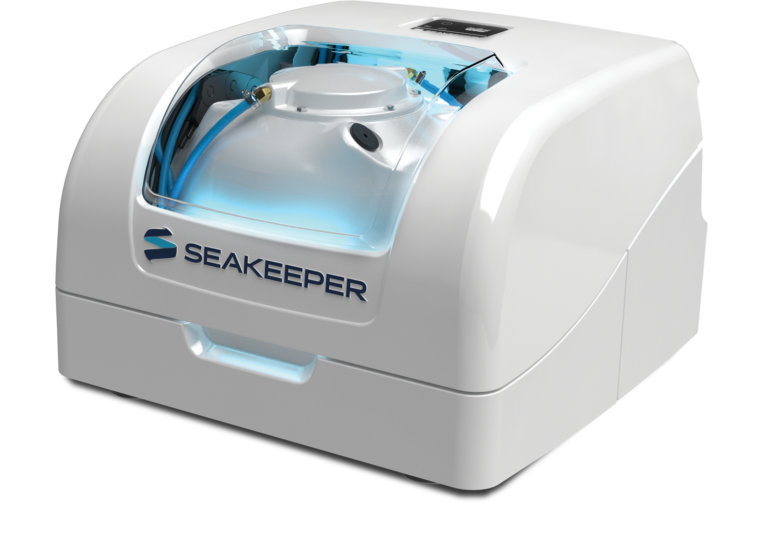
This manual is applicable to Seakeeper 1 models with serial number 1-233-0631 to 1-243-0874.
2.0 System Overview
The Seakeeper 1 uses gyroscopic principles to dampen cyclic boat roll motions in waves and wakes. In installations involving multiple Seakeepers, each Seakeeper operates independently of one another; therefore, this manual only discusses the operation of a single unit.
Reduction of boat roll is a function of the boat’s displacement, transverse metacentric height (GMT), and hull damping as well as the operating conditions (speed and heading with respect to waves) and sea state. Seakeeper’s active control regulates the hydraulic brake to ensure the Seakeeper’s anti-roll torque is maximized irrespective of hull characteristics or operating conditions.
Operation of the Seakeeper 1 requires mechanical, electrical, and plumbing interfaces with the boat. Figure 1 illustrates the interconnection of these components and their interface with the boat. The Seakeeper 1 requires a connection to a display to support the Seakeeper Application; display options include a compatible MFD or Seakeeper 5” Touch Display.
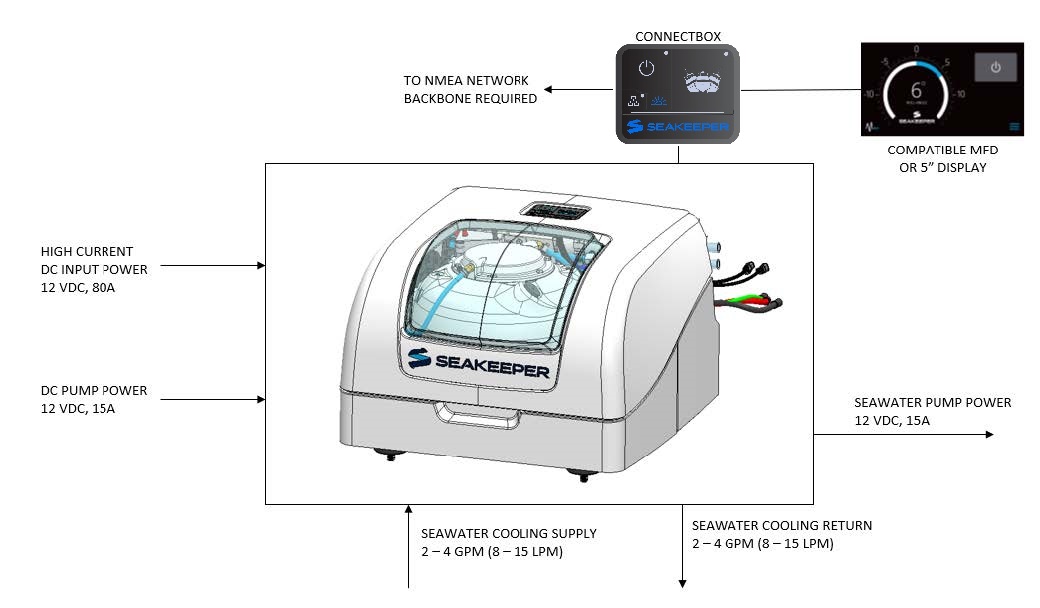
Seakeeper 1 technical specifications provided in Section 6, list the power consumption, total weight, and dimensions of the major components. Gyroscopic principals that apply to boat roll control are discussed on Seakeeper’s website at www.seakeeper.com. The Seakeeper website also contains videos of Seakeeper operation and a variety of different boats operating in waves with the Seakeeper on and off. It is recommended that the reader play these videos prior to reading the remainder of this manual.

There is a large torque about the gimbal axis when the Seakeeper is precessing. The Seakeeper 1 enclosure is provided to prevent personnel or equipment from contacting the Seakeeper while it is in operation. The enclosure should not be stood on or have anything placed on top. The enclosure should always be in place during operation. If it is ever necessary to touch the Seakeeper while the flywheel is spinning, the Seakeeper must be locked at the display to stop the Seakeeper from precessing. Seakeeper maintenance should not be attempted unless the Seakeeper is locked and the flywheel has stopped spinning.
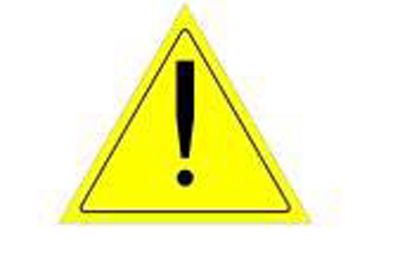
Boat operators are advised that the Seakeeper’s sole function is to dampen a boat’s cyclic roll motions. The Seakeeper is not, and is not intended to be, a substitute for adequate hull stability about the pitch, roll and yaw axes and the Seakeeper is not designed to prevent any instability due to improper boat operation, including, without limitation, any aggressive maneuvers at high speed. During aggressive maneuvers at high speed, the Seakeeper outputs a constant pitch moment which can create a small bow-down or bow-up trim change.
Improper boat operation including, without limitation, aggressive maneuvers at high speed can result in the boat becoming unstable. If you intend to operate the boat in such a manner, you should lock the Seakeeper in the vertical position before operating the boat in that manner. This is easily accomplished by turning the boat to starboard at slow speed in the Stabilize mode. After turning to starboard for 5 seconds, turn the Stabilize mode off while continuing to turn and then go to the Service Page on the display and confirm the Gyro Angle is within +10 degrees of 0 degrees.
3.0 System Operation
3.1 ConnectBox and Display Screen Overview
Introduction
The Seakeeper 1 requires the ConnectBox and connection to either, preferably, a compatible MFD or a Seakeeper 5” Touch Display. The compatible MFD and Seakeeper 5” Touch Display will show the same Seakeeper Application outlined in this section.
When 12 VDC power is applied to the Seakeeper, the ConnectBox will illuminate and the Seakeeper Application on the MFD or 5” Touch Display will initialize. If connecting the ConnectBox to an MFD, and the Seakeeper App does not appear on the MFD, please refer to appropriate Technical Bulletin to troubleshoot, at www.seakeeper.com/technical-library/ and filter for the Seakeeper 1:
- TB 90478 – Garmin and Seakeeper Compatibility
- TB 90479 – Raymarine and Seakeeper Compatibility
- TB 90480 – Simrad and Seakeeper Compatibility
- TB-90598 – Furuno and Seakeeper Compatibility
- TB-90482 – Display Screens Overview
- 90569 – Seakeeper ConnectBox and Application Quick Start Guide
ConnectBox Overview
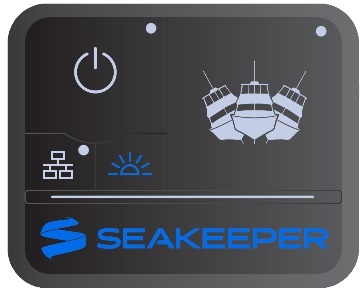
- The ConnectBox POWER button will pulse red if the Seakeeper causes an alarm. The alarm must be addressed on the Seakeeper Application.
- The BRIGHTNESS button
 on the ConnectBox will toggle through different brightness settings of the ConnectBox LED brightness.
on the ConnectBox will toggle through different brightness settings of the ConnectBox LED brightness. - The ETHERNET button
 on the ConnectBox allows integration with Multifunction Displays (MFD). Pressing the button for several seconds will show the ConnectBox synchronization mode by strobing progress bar left or right. The progress bar is beneath the brightness and ethernet buttons. See applicable MFD and Seakeeper Compatibility technical bulletin for further information.
on the ConnectBox allows integration with Multifunction Displays (MFD). Pressing the button for several seconds will show the ConnectBox synchronization mode by strobing progress bar left or right. The progress bar is beneath the brightness and ethernet buttons. See applicable MFD and Seakeeper Compatibility technical bulletin for further information.
ConnectBox and Home Screen
- After the Seakeeper ConnectBox and Application have initialized, the ConnectBox and Application Home Screen will be displayed as shown below.

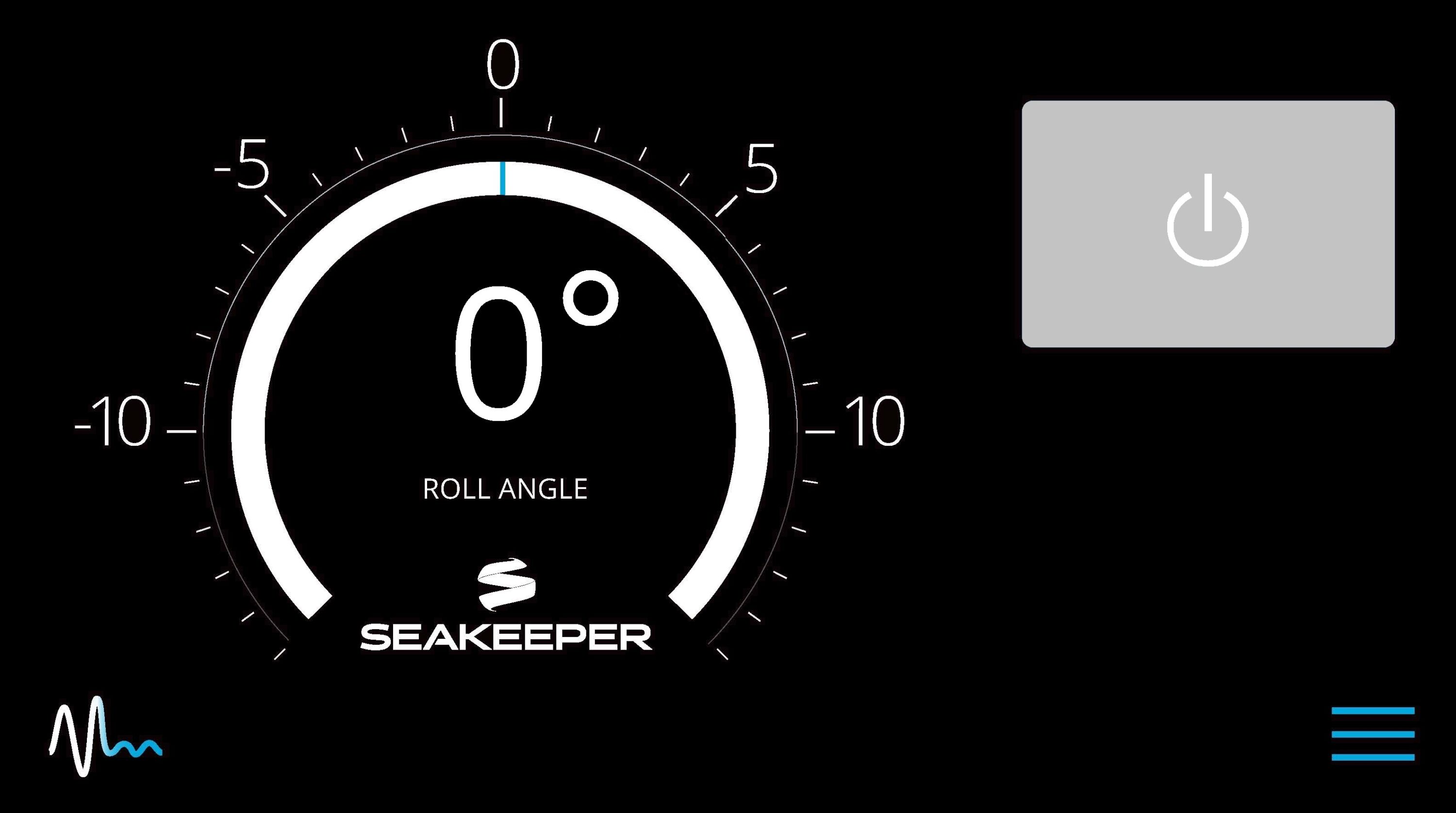
- The Seakeeper can be controlled by either the ConnectBox (shown in images on left) or the Application on the compatible MFD or Seakeeper 5” Touch Display (shown in images). Seakeeper POWER button: when pressed, the button will change from grey (Seakeeper Off) to blue (Seakeeper On).

- Seakeeper STABILIZE button: when pressed, the button will change from grey (Stabilize Off) to blue (Stabilize On).

- On the MFD or 5″ Touch Display Application Home Screen view, these buttons can be pressed to toggle Home Screen views between the Roll Angle Gauge and the Roll Angle Graph as shown below.

- When the MENU button is pressed,
 the Menu Bar will appear or disappear at the bottom of the screen.
the Menu Bar will appear or disappear at the bottom of the screen.

- The Menu Bar is used to navigate between pages. From left to right, the available pages are Home, Settings, Information, Service, and Alarm History. The selected page is highlighted in blue on the Menu Bar.

Settings Page
- The Settings Page allows the user to adjust their preferences for the Seakeeper and its display. It can be accessed by pressing the gears
 in the menu bar.
in the menu bar.
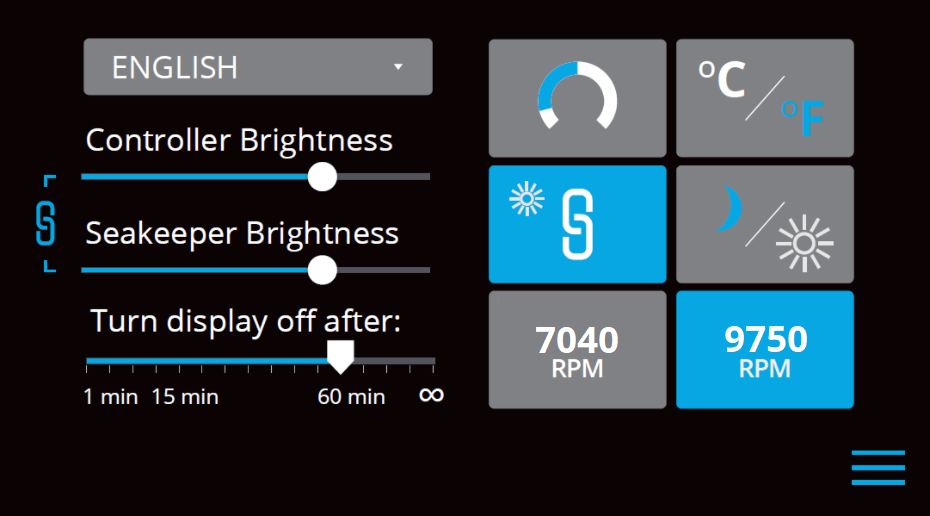
- The language on the Seakeeper Application can be changed using the Settings Page. By clicking ENGLISH, a dropdown appears, and the desired language can be selected.

- On the Seakeeper 5” Touch Display only, there is a sleep timer. Adjust the sleep timer from 1 minute to infinite using sleep time slider. Touching the screen will wake the display up after it has gone to sleep. The MFD should be controlled within the MFD’s settings.

- If the Seakeeper is facing the bow of the vessel, the Roll Angle Gauge should show the blue on the left (pictured left). If the Seakeeper is facing the stern of the vessel, one should select the Roll Angle Gauge with the blue on the right (pictured right). A positive roll angle should be displayed when the vessel rolls to starboard.


- Change the speed of the Seakeeper between normal operation and quiet mode operation. Quiet Mode consumes less power and should generate less noise. The selected speed is colored blue. When power is cycled (or Seakeeper turned Off), this speed will default back to the normal operating speed.

- Change the display between day and night mode. The selected mode is colored blue and to change between day and night mode, press the button.

- Change the units of the temperatures displayed on the Service Page between degrees Celsius and degrees Fahrenheit. The selected units are colored blue.

Information Page
The information page ![]() displays the Seakeeper Model, Serial Number, Software Versions, Run Hours, Sea Hours, and other information. NOTE: The image below is an example and may not match information details of installed Seakeeper.
displays the Seakeeper Model, Serial Number, Software Versions, Run Hours, Sea Hours, and other information. NOTE: The image below is an example and may not match information details of installed Seakeeper.
.
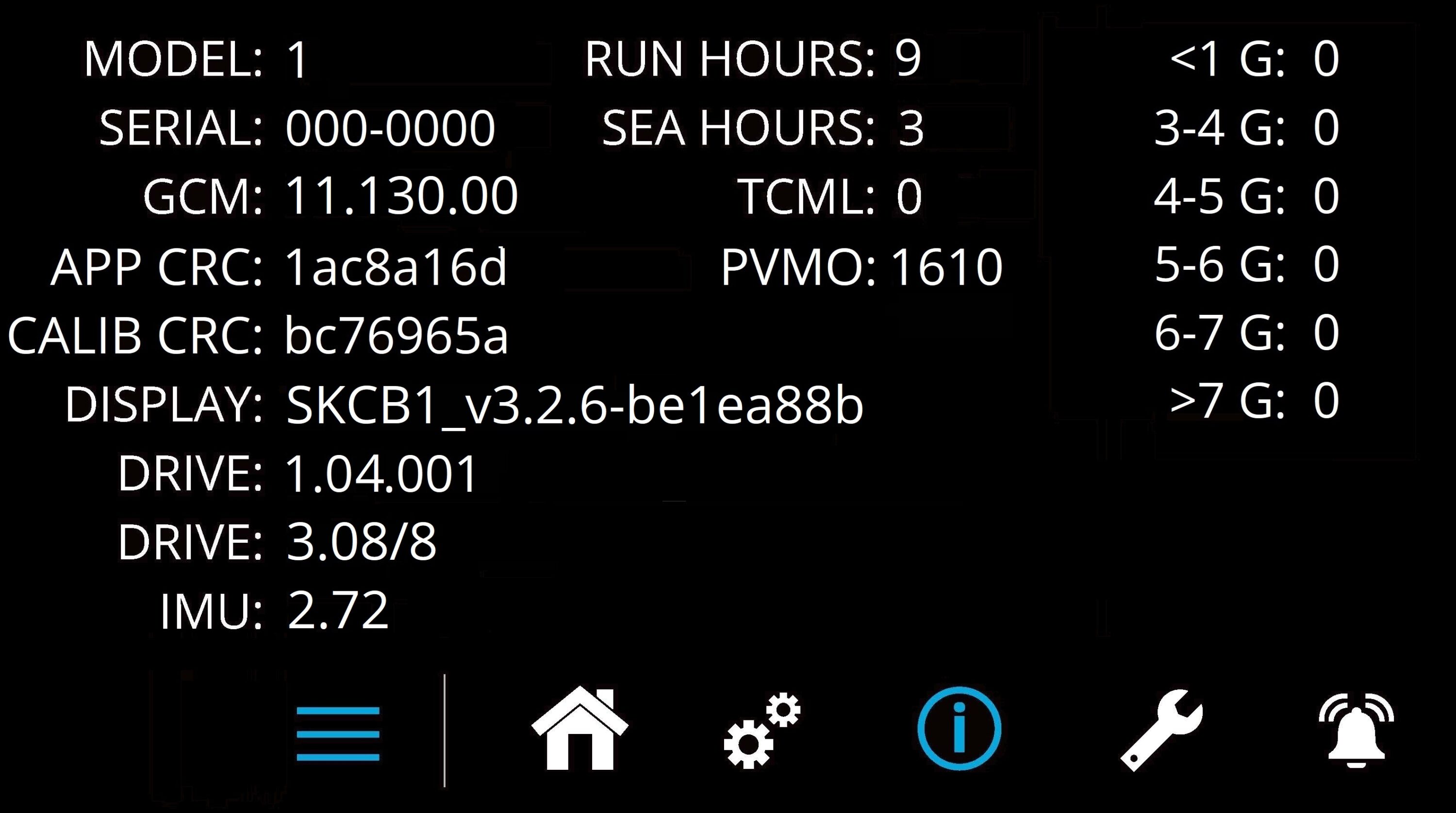
Service Page
The Service Page ![]() displays Seakeeper operating information.
displays Seakeeper operating information.
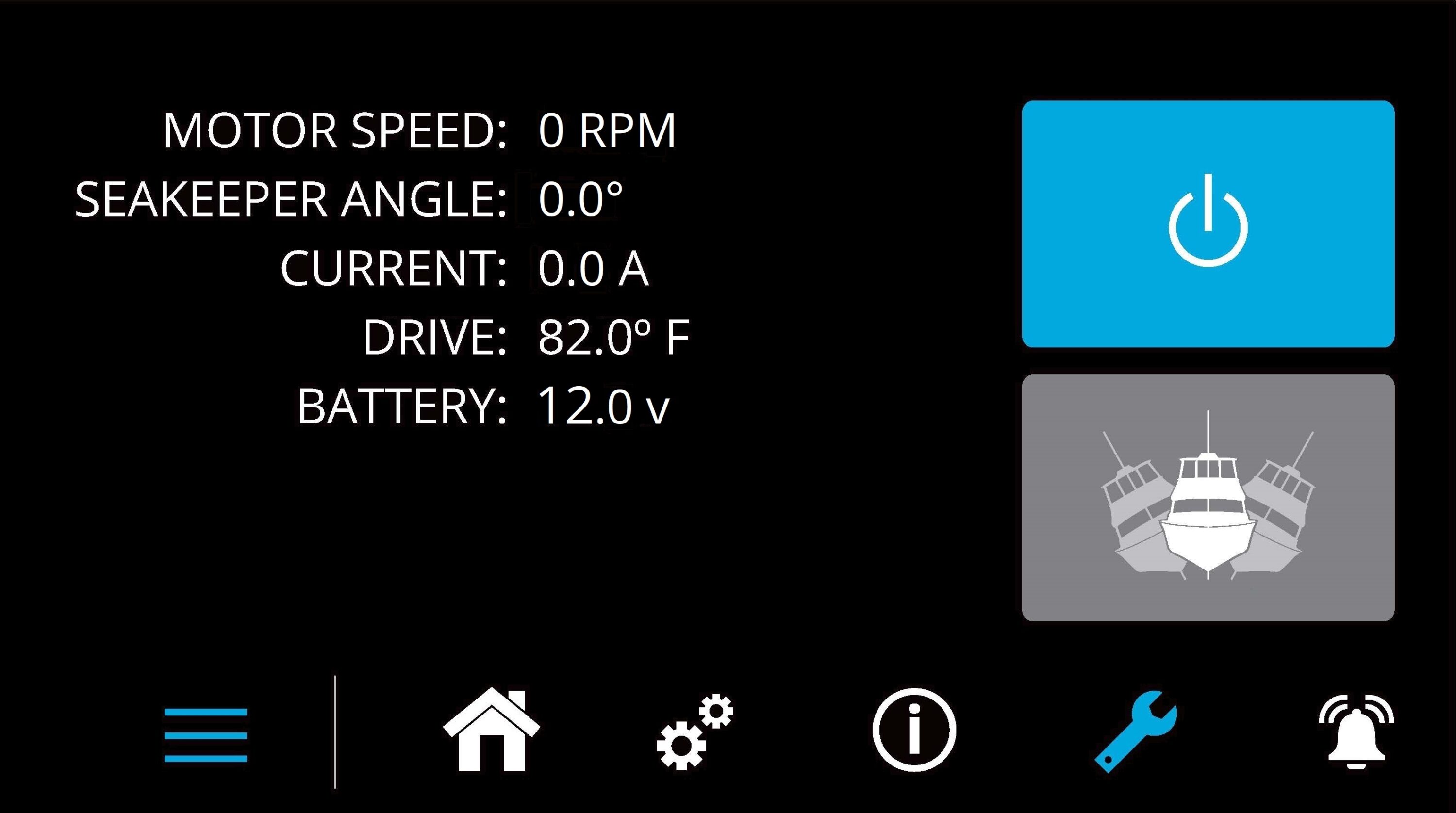
Alarm History Page
The Alarm Page ![]() displays Seakeeper alarm history.
displays Seakeeper alarm history.
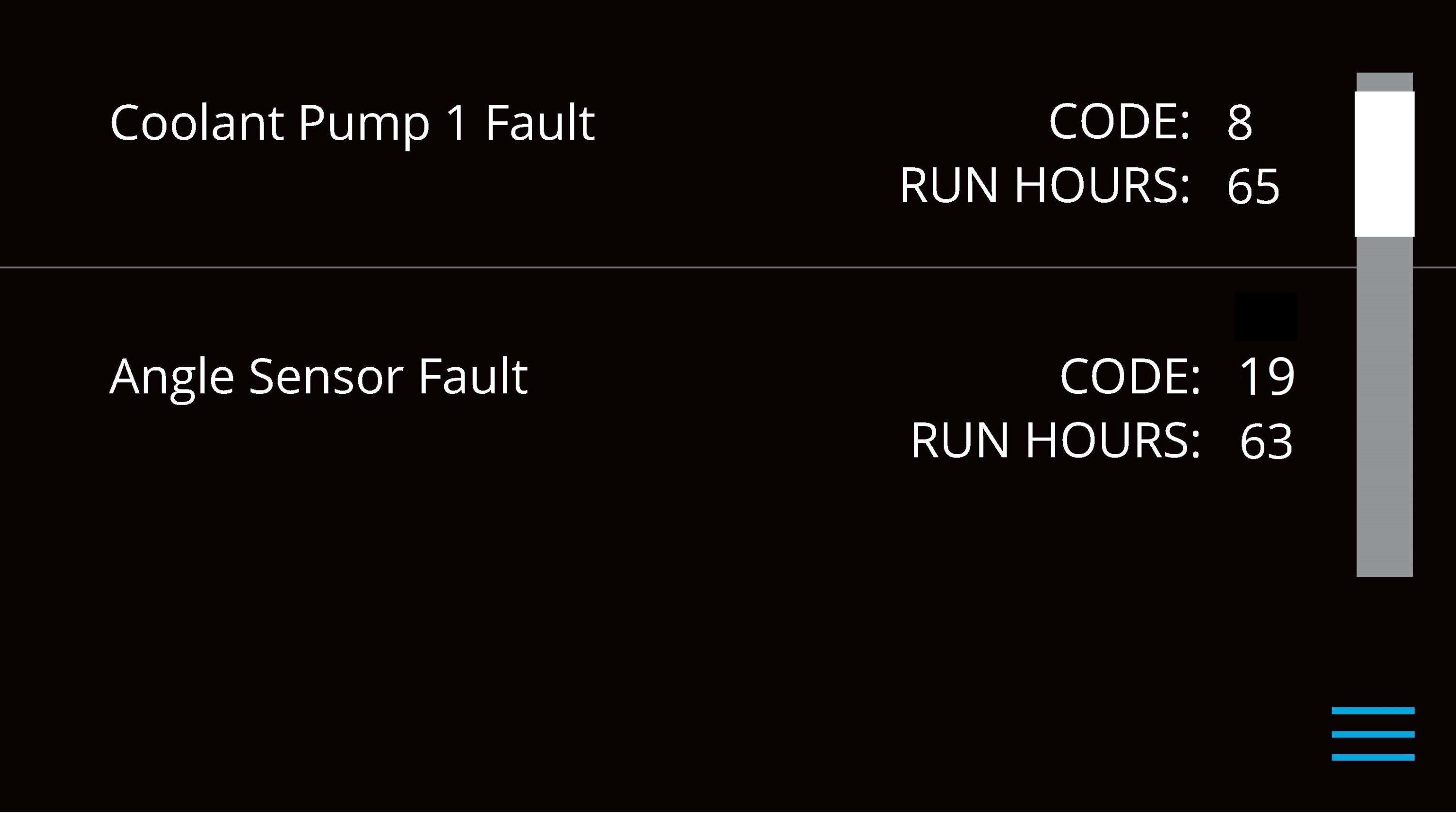
3.2 Operating Instructions
Start Up
- Energize Seakeeper 1 Battery Isolation Switch.
- Energize Seakeeper 1 High Current DC Power Supply (12 VDC, 80 A) at customer-supplied circuit breaker.
- Energize 12 VDC seawater pump power supply at the customer-supplied circuit breaker (unless a fuse is supplied as overcurrent protection).
- When the high DC power is turned on, the ConnectBox and Seakeeper 5” Touch Display and/or MFD application will initialize as seen below. The Seakeeper 1 can be powered on and controlled by either the Seakeeper Application or the ConnectBox.
- With system energized, check the Seakeeper display for any ALARMS. If there are any ALARMS present, they must be addressed to proceed.

- To turn the Seakeeper on, press the POWER button; the button will turn blue. The progress bar will appear and indicate how soon the Seakeeper will be available for stabilization. The progress bar indicates the speed of the flywheel as it accelerates to its rated operating RPM.

- When the Seakeeper is initialized and up to Stabilization RPM the STABILIZE button will appear on the application, or if using the ConnectBox, the STABILIZE button will illuminate blue and pulsate. At this point, the Seakeeper is available for stabilization by pressing the STABILIZE button.

- The progress bar indicating flywheel spool-up will disappear from the display screen once the STABILIZE button is pressed (turns blue) and the ConnectBox will fully illuminate. At this point, the Seakeeper has reached its rated operating RPM and maximum stabilization is available. If the STABILZE button has not been pressed (button is grey), pressing the button will turn it blue and stabilization will be provided. The seawater pump will cycle on and off based on the operating temperature of the Seakeeper 1.

Stabilization

If it is necessary to shut off power to the flywheel motor and slow the flywheel for any reason, press Seakeeper On/Off button; the button will turn grey and the Stabilize button will disappear, indicating the command has been accepted. It takes approximately 8+ hours for the speed to slow down to 0 RPM.
___________________________________________________________
If it is necessary to stop Seakeeper motion for any reason, press the Stabilize button. The Stabilize button will turn grey indicating that the Seakeeper is locked. Never attempt to work on the Seakeeper until the flywheel has stopped spinning. In the event that the brake system has automatically locked the Seakeeper due to an alarm or failure, no attempt should be made to bypass the alarm or automatic lock.
To stabilize the vessel after the Seakeeper is On and the flywheel is above the minimum stabilization RPM:
Press the STABILIZE button. The button will turn blue indicating that the Seakeeper is stabilizing the roll motion.

Boat operators are advised that the Seakeeper’s sole function is to dampen a boat’s cyclic roll motions. The Seakeeper is not, and is not intended to be, a substitute for adequate hull stability about the pitch, roll and yaw axes and the Seakeeper is not designed to prevent any instability due to improper boat operation, including, without limitation, any aggressive maneuvers at high speed. During aggressive maneuvers at high speed, the Seakeeper outputs a constant pitch moment which can create a small bow-down or bow-up trim change.
Improper boat operation including, without limitation, aggressive maneuvers at high speed can result in the boat becoming unstable. If you intend to operate the boat in such a manner, you should lock the Seakeeper in the vertical position before operating the boat in that manner. This is easily accomplished by turning the boat to starboard at slow speed in the Stabilize mode. After turning to starboard for 5 seconds, turn the Stabilize mode off while continuing to turn and then go to the Service Page on the display and confirm the Gyro Angle is within +10 degrees of 0 degrees.
Speed Adjustment
- Press the Menu button
 , then select the Settings screen
, then select the Settings screen  .
. - Select the desired RPM button to adjust the Seakeeper’s speed. The selected RPM button will turn blue. Speed selection buttons shown below are examples and may not match operating speed of installed Seakeeper.

Seakeeper 1: Normal operational speed is 9750 RPM. Quiet mode operates at 7040 RPM, which allows stabilization at a reduced flywheel speed. After a 12 V power cycle to the Seakeeper, the speed selection will remain on the previously selected speed.
Normal Shutdown

The Seakeeper should be stopped when stabilization is no longer required. Once the vessel is secured in the slip, the high and low current DC power to the Seakeeper should be switched to the Off position. The Seakeeper will continue to spool down to 0 RPM. No cooling is required during this time. Note Seakeeper will take 2+ hours to coast down to 0 RPM from full speed.
Note: The seawater pump may run for up to 5 minutes after the Seakeeper is switched off and is coasting (with low current DC power applied).
- Press the Seakeeper POWER button. The POWER button will turn grey. The Seakeeper will discontinue stabilization and the flywheel will start coasting.
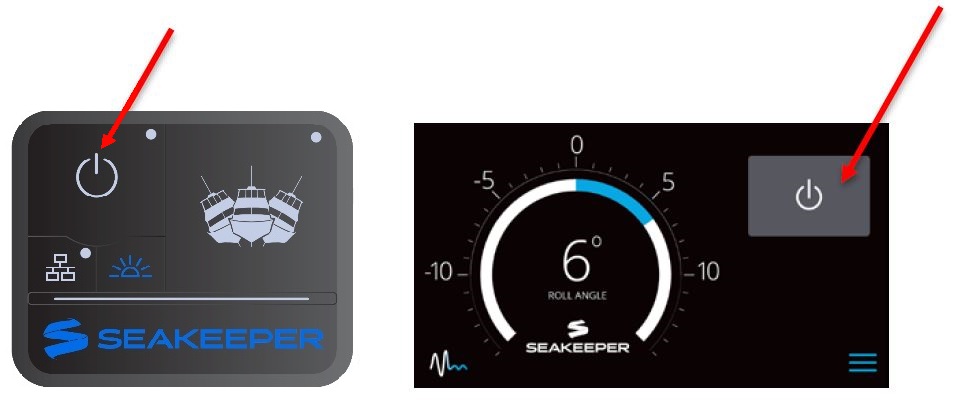
- Once the vessel is secured in the slip, switch the high current (80 A circuit breaker) and low current (circuit breaker rated per seawater pump) DC power to the Seakeeper off. The flywheel will continue to spool down to 0 RPM. This can take 2+ hours from full speed. When the flywheel has stopped spinning, 0 RPM will appear on the service screen.
4.0 Power Failures, Alarms, and Troubleshooting
4.1 Power Failures, Alarms, and Troubleshooting Introduction

The operator should physically examine the Seakeeper following an alarm. Continuing to reset alarms without service intervention can result in damage or personnel injury.
_____________________________________________________
The Motor Drive Box contains a voltage hazard and the cover should not be removed while the flywheel is spinning or the DC input voltage is present. This voltage hazard exists even if the flywheel is coasting down and the supply voltage has been shut off.
_____________________________________________________
The Motor Drive Box contains a voltage hazard and the cover should not be removed while the flywheel is spinning or the DC input voltage is present. This voltage hazard exists even if the flywheel is coasting down and the supply voltage has been shut off.
The Seakeeper 1 has safety features, such as alarms and warnings, that pop-up on the Seakeeper Application and are signaled on the ConnectBox to protect the Seakeeper as well as the vessel. The brake can be locked from the Application, ConnectBox or by shutting off DC power at the supply breakers, preventing the Seakeeper from precessing.
In the event of a power failure, the brake automatically locks the Seakeeper so it cannot generate anti-rolling torque loads. When a power failure occurs, it is important to identify the three sources of power to the Seakeeper 1:
- 12 VDC high current powers the Motor Drive Box to drive the motor inside the Seakeeper and electronic controls.
- Seawater Pump 12 VDC Input powers the seawater cooling pump.
These are supplied on cables which are shown on Drawing No. 90511 – Seakeeper 1 Cable Block Diagram.
Voltage-Related alarms include the following:
- DC INPUT VOLTAGE HIGH – Code 40
- Alarms when low current DC input voltage varies from a reasonable range for the design voltage.
- DC INPUT VOLTAGE LOW – Code 41
- Alarms when low current DC input voltage varies from a reasonable range for the design voltage.
- DC INPUT VOLTAGE LOW [SPEED LOSS DURING OPERATION] – Code 111
- DC INPUT VOLTAGE LOW [SLOW SPOOL UP] – Code 112
- Code 11 and 112 occur to adjust power consumption as voltage drops below 11.1 VDC to prevent battery depletion. If battery voltage drops to 10 VDC, code 167 will trigger.
- BATTERY STATE OF CHARGE – Code 123
- This alarm alerts the operator of a low state of charge (SoC) if the Seakeeper is receiving a SoC signal over the NMEA 2000 network and SoC based protection is enabled in the Battery Monitor Configuration. The SoC will depend on the cut-off threshold slider setting (see Section 3.3).
- The Battery icon on the Home screen will appear red and empty.
- HIGH CURRENT DC VOLTAGE LOW – Code 167
- HIGH CURRENT DC VOLTAGE HIGH – Code 168
- This alarm protects the Seakeeper 1 from an over-voltage of 15 VDC or higher.
4.2 Power Failures
In the event of a power failure, the brake automatically locks the Seakeeper so it cannot generate anti-rolling torque loads.
When a power failure occurs, it is important to identify the two sources of power to the Seakeeper 1:
- High current 12 VDC in, powers the control electronics and motor drive.
- SW Pump 12 VDC in, powers the seawater cooling pump.
These are supplied on Conductors 1 and 2 and Cable 7 which are shown on Drawing No. 90511 – Seakeeper 1 Cable Block Diagram.
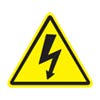
The Motor Connections should not be touched when the Seakeeper is powered on or the motor is running. This voltage hazard exists even if the flywheel is coasting down and the supply voltage has been shut off. The flywheel must be at 0 RPM and DC input power disconnected for at least 10 minutes prior to any service work on the Seakeeper.
4.3 12 VDC High Current Failure
If the 12 VDC high current is disconnected during operation, the Seakeeper Application will go blank, ConnectBox lights will power down, flywheel speed will decrease, and the Seakeeper 1 will lock to prevent precession (no stabilization).
- Verify the boat’s overcurrent protection supplying +12 VDC high current has not tripped nor blown.
- When +12 VDC high current is restored, the Seakeeper App will power up on the display (MFD or 5” Touch Display), the start-up screen will appear, and then the Home Screen will appear. The ConnectBox will illuminate.
- Press POWER button
 . The progress bar will appear and indicate flywheel speed. When the flywheel is at minimum operating speed, the STABILIZE button will appear so stabilization can be turned on. This may take up to 15 minutes, depending on the speed of the flywheel when the +12 VDC high current is turned back on.
. The progress bar will appear and indicate flywheel speed. When the flywheel is at minimum operating speed, the STABILIZE button will appear so stabilization can be turned on. This may take up to 15 minutes, depending on the speed of the flywheel when the +12 VDC high current is turned back on.
4.4 Alarms & Notifications

The operator should physically examine the Seakeeper following an alarm. Continuing to reset alarms without service intervention can result in damage or personnel injury.
Alarms
Sensors, alarms, and shutdowns are provided to allow unattended operation. Sensors measure drive temperatures, gimbal angle, brake pressure, and vessel motion. The Seakeeper controller sends sensor values and alarm information to the display and locks the brake and shuts down the motor drive in the event of an alarm condition. Seakeeper operating history during faults or alarms is recorded in the controller’s memory for subsequent recall if service is needed. Seakeeper and Seakeeper Dealers may access the Seakeeper’s software to gather run hours, bearing loading, and hull slamming information.
NOTE: The ConnectBox indicates the presence of an alarm only. The Seakeeper Application must be used on either the MFD or the Seakeeper 5” Touch Display to identify and address the alarm.
The alarm will not clear until the operator presses the Reset Alarm button and the alarm condition is no longer present. The operator can then press the POWER button again to resume Seakeeper operation.
- A view of a typical Alarm screen.
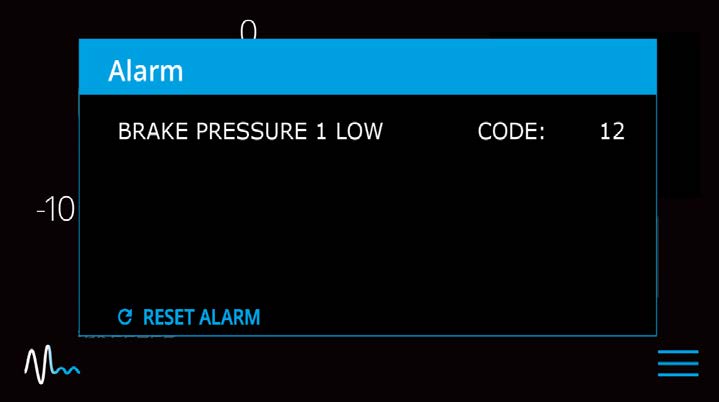
- To reset the alarm, press the RESET ALARM button:

Troubleshooting
- At MFD app or 5″ Touch Display, check for alarms or warnings.
- Power Supply: Check electrical power source breakers ON or fuses installed and NOT blown.
- Mechanical Components:
- For temperature -related alarm, verify the coolant reservoir is filled with glycol mixture (50% ethylene glycol/50% distilled water). Verify seawater pump power aligned.
- Visually check mechanical fittings and joints for leakage.
- Visually check coolant and brake hoses for chaffing and leakage.
- Contact an authorized Seakeeper dealer for further assistance in diagnosing and resolving complex alarms.

If a GPS signal is lost, a warning message will appear in the Alarm History and a message will appear on the Home Screen, as seen below. The Seakeeper will not spool down, however the precession rate and angle of the sphere will be reduced until GPS signal returns.
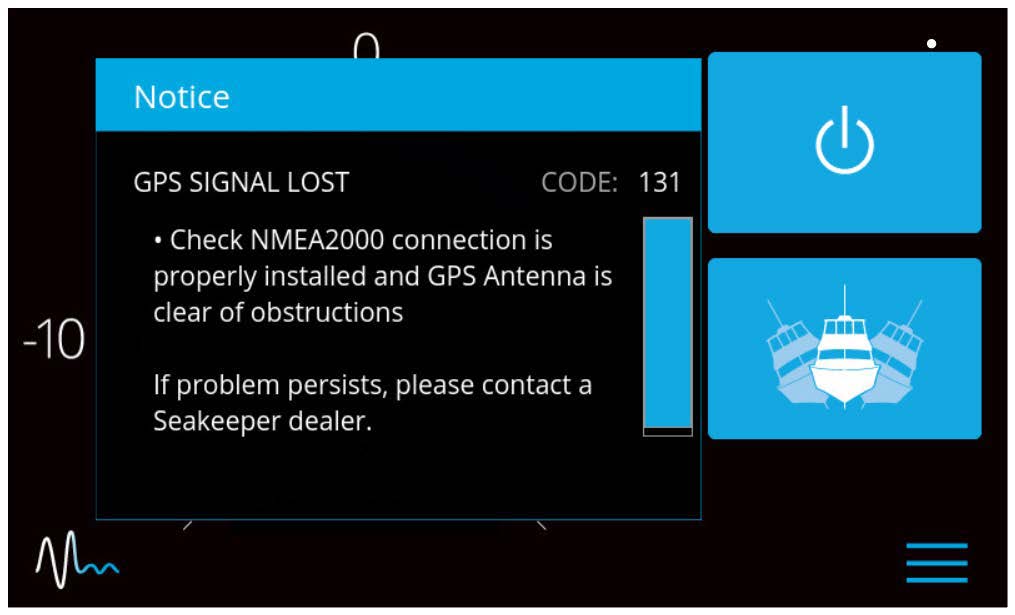
Notifications
Several notifications are programmed to pop up upon certain events. They do not affect the operation of the Seakeeper, and each notification may be dismissed or suppressed. Models produced or updated with software after September 2024 will have the following notifications:
Rinse Reminder
Upon pressing power button to turn OFF Seakeeper and start coast down, the Rinse Reminder notification will appear to remind the user to rinse the Seakeeper with mild soap and fresh water after use. Pressing the OK button will acknowledge the notification and it will not reappear until the next coast down event.
The QR code links the user to the Freshwater Rinse article on the Seakeeper website. If the Seakeeper was exposed to saltwater spray, it is desirable to rinse the Seakeeper to maintain cosmetic condition.

Maintenance Reminder
Seakeeper recommends routine service every 1000 run hours to maintain the Seakeeper in peak condition. To assist the user in Seakeeper maintenance, the Maintenance Service Reminder will appear after 1000 Run Hours has elapsed since the last reset of the Service Reminder. The “Next Service Reminder” timer can be found in the Service page, as shown below. Below the Next Service Reminder timer is the reset button that resets the timer to 1000 Run Hours.

When the timer reaches 0 Run Hours, the notification will appear in a popup on the Seakeeper app. The user has an option to suppress the reminder until the next Seakeeper power cycle by selecting “Remind Me Later” or the user can reset the timer by selecting the “Reset Service Reminder”.
The QR code links the user to the Seakeeper Recommended Maintenance Schedule on the Seakeeper website.
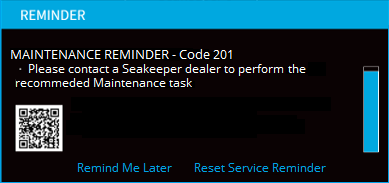
Warranty Registration Reminder
Before warranty work can occur, a Seakeeper must be registered. Registering your Seakeeper before warranty service is required is recommended to allow for expedient service if needed. Registration also includes the user in any important Seakeeper notifications that may affect their unit.
At 20 Run Hours on the Seakeeper, a Registration Reminder notification will appear on the Seakeeper app. The reminder occurs only once in the life of the Seakeeper. To dismiss the reminder, press OK on the popup window.
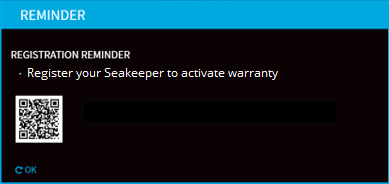
4.5 Alarm History
The Alarm History page on the Seakeeper Application shows the recent alarms and warnings. Alarms trigger a pop-up message to be displayed on the Seakeeper App and cause the ConnectBox power button to pulse red as alarms affect Seakeeper operation. Warnings will be listed in the alarm history but do not affect Seakeeper operation. The alarms and warning history are in chronological order starting with the most recent. Press the MENU button ![]() to show the page options and then the ALARM button
to show the page options and then the ALARM button ![]() to show alarm history.
to show alarm history.

5.0 Maintenance
5.1 Maintenance Introduction

Due to remote start capabilities of MFDs, ENSURE power removed from Seakeeper and flywheel at zero RPM at display/MFD app before removing covers.
Hydraulic Hand Pump Kit is required for servicing the brake. Pressure should NOT be relieved unless this tool is available.
Seakeeper recommends a regular inspection interval and scheduled maintenance to keep the Seakeeper 1 running trouble-free.
If the Seakeeper is installed in a wet space, efforts should be made to keep the Seakeeper free of salt residue from either condensation or direct exposure to salt spray. If exposed, a regular wipe down and a rinse will help limit corrosion and keep the Seakeeper assembly in good cosmetic condition. Refer to Seakeeper Care article for details.
If any components of the Seakeeper or its sub-systems will be exposed to environmental temperatures where winterization is necessary for storage, reference Seakeeper Winterization article.
The Seakeeper comes standard with sealant and thread locker on applicable fasteners. When reinstalling all fasteners, use thread locker (Loctite 243 or equivalent) and sealant unless otherwise specified.
Reference Documents:
5.2 Recommended Scheduled Maintenance Table
The following contains the scheduled maintenance table organized by RUN hours. Scheduled maintenance is not covered under warranty.
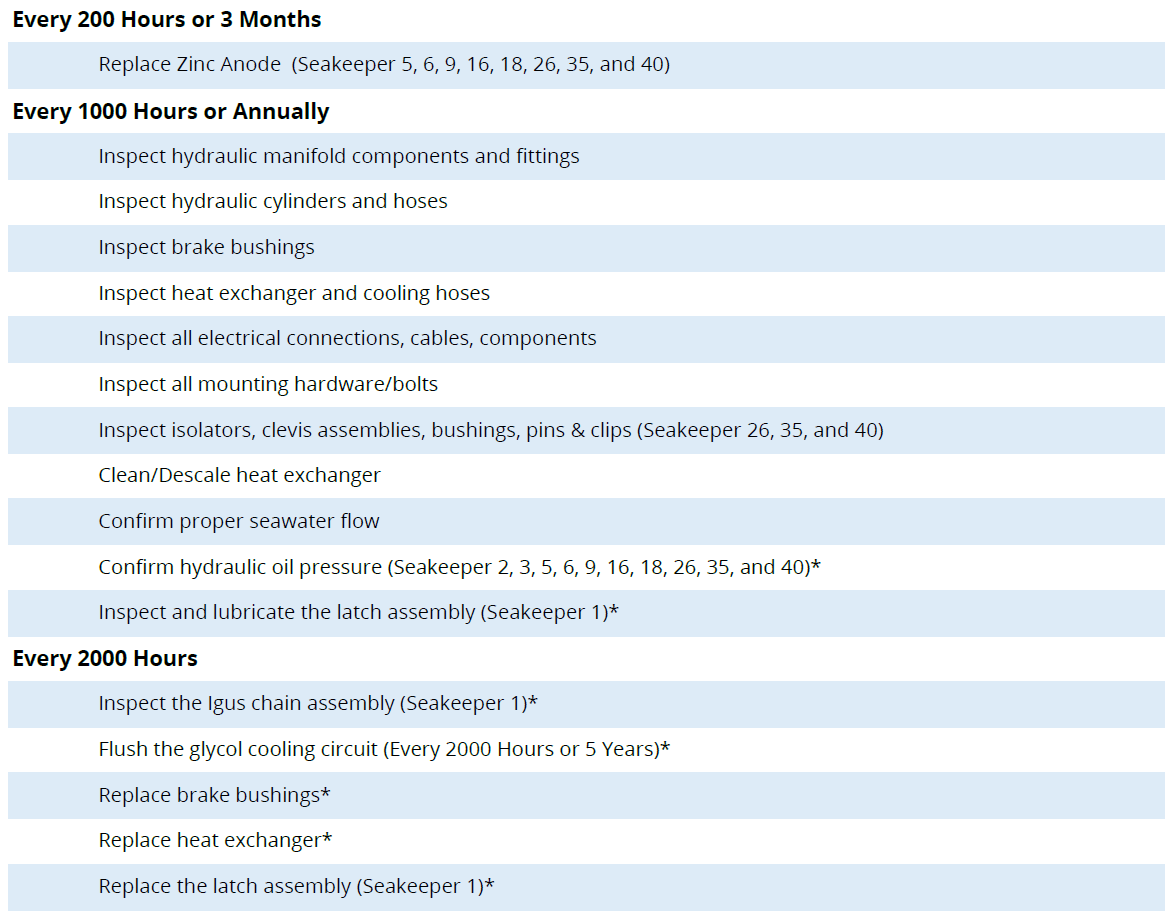
*These tasks must be performed by a certified Seakeeper Dealer.
Find a local Dealer at www.seakeeper.com/find-us
Perform the Recommended Maintenance after the indicated number of Running [RUN] hours or Years since last maintenance, whichever occurs first.
Seakeepers are designed for use in a marine environment and to withstand occasional water spray or splash. Prolonged exposure to seawater, however, can cause premature wear and damage to the unit; therefore, it is important to apply a gentle fresh water rinse following exposure to seawater.
The service intervals are based on ‘average’ use, including operating in various Sea conditions, such as zero or low-speed usage in/around marinas and anchorages vs. different speeds while underway in light or heavy sea conditions. If the customer’s normal operating conditions include extended SEA operation, more frequent service should be considered.
6.0 Warranty, Limit of Liability, Property Rights
6.1 Warranty
The complete Seakeeper warranty details may be found on the Seakeeper website www.seakeeper.com.
6.1.1 Seakeeper Recreational Limited Warranty Policy
Seakeeper warrants that the Goods sold hereunder are free from defects in material and workmanship. This warranty starts from the earlier of the purchase date by the first end-user/retail purchaser or the in-service date, and the warranty period is for the shorter of the following periods:
- 24 months (2 years) from date the Product is put into service, which shall conclusively be presumed to be the date of sale of a vessel on which the Product is installed, to a retail customer or date put into service on an existing vessel (refit), or
- 2000 (two thousand) operating SEA hours, subject to verification and confirmation by SEAKEEPER, INC.
6.1.2 All Seakeeper Models
This warranty does not cover normal wear of the following components or the costs associated with maintenance, repair or replacement:
- Surface Corrosion (Cosmetic) on any component due to exposure
- Heat Exchanger
- Brake Bushings
- Isolation Bushings
- Normal preventive and scheduled maintenance and component inspections/replacements as specified in the Seakeeper, Inc., Operation Manuals and any other Maintenance Schedule documentation.
This express warranty is in lieu of and excludes: ALL OTHER WARRANTIES, EXPRESSED OR IMPLIED, BY OPERATION OF LAW OR OTHERWISE INCLUDING WARRANTIES OF MERCHANTABILITY OR FITNESS FOR A PARTICULAR PURPOSE (WHETHER KNOWN TO SELLER OR NOT), AND ALL OTHER SUCH WARRANTIES ARE HEREBY EXPRESSLY DISCLAIMED BY SELLER AND WAIVED BY CUSTOMER/END USER. SEAKEEPER, INC. SHALL IN NO EVENT BE LIABLE TO ANY SPECIAL, DIRECT, INDIRECT, INCIDENTAL OR CONSEQUENTIAL DAMAGES FOR BREACH OF ANY WARRANTY OR OTHER OBLIGATION ARISING OUT OF THE SALE OF THE PRODUCTS, OR FROM THE USE OF THE PRODUCTS OR ANY INABILITY TO USE THE PRODUCTS.
Written notice of claimed defects shall have been given to Seakeeper within the Warranty Period, and within thirty (30) days from the date any such defect is first discovered. The Goods or parts claimed to be defective must be returned to Seakeeper, accompanied by a Return Authorization (RA) issued by Seakeeper‘s facility responsible for supplying Goods, with transportation prepaid by Buyer/User, with written specifications of the claimed defect.
If a warranty claim is valid, SEAKEEPER, INC. will repair or replace the Product, or part of the Product, proven to be defective, at its sole discretion, in a timeframe provided by SEAKEEPER, INC., on a reasonable best effort basis.
Under no circumstances shall Seakeeper be liable for removal of Seakeeper‘s Goods from Buyer’s/User’s equipment or re-installation into Buyer’s/User’s equipment. No person including any agent, distributor, or representative of Seakeeper is authorized to make any representation or warranty on behalf of Seakeeper concerning any Goods manufactured by Seakeeper
6.1.3 Warranty Activation
A Warranty Registration must be fully completed and sent to Seakeeper, Inc., for review, approval and registration upon delivery of the vessel to the first retail customer. Warranty registration and expiration date confirmation can be achieved by providing Seakeeper, Inc., a copy of the original bill of sale, purchase agreement, Owner’s name, address and Seakeeper Stabilizer Serial Number along with current Run / Sea hours to Seakeeper’s warranty registration department within thirty (30) days of purchase. For removal of doubt, it is clarified that the activation date shall in no event affect the warranty period set forth herein.
“Owner” is defined as the first retail customer (purchaser), or subsequent customer (by transfer), of the Seakeeper Product as identified in Seakeeper warranty registration(s).
6.2 Limitation of Liability
NOTWITHSTANDING ANYTHING TO THE CONTRARY, SEAKEEPER SHALL NOT BE LIABLE FOR ANY SPECIAL, INCIDENTAL, INDIRECT OR CONSEQUENTIAL DAMAGES INCLUDING BUT NOT LIMITED TO LOST PROFITS ARISING OUT OF THE PERFORMANCE, DELAYED PERFORMANCE OR BREACH OF PERFORMANCE OF THIS ORDER REGARDLESS WHETHER SUCH LIABILITY BE CLAIMED IN CONTRACT, EQUITY, TORT OR OTHERWISE. SEAKEEPER’S OBLIGATION IS LIMITED SOLELY TO REPAIRING OR REPLACING (AT ITS OPTION AND AS SET FORTH IN SECTION 5), AT ITS APPROVED REPAIR FACILITY, ANY GOODS OR PARTS WHICH PROVE TO SEAKEEPER’S SATISFACTION TO BE DEFECTIVE AS A RESULT OF DEFECTIVE MATERIALS OR WORKMANSHIP, IN ACCORDANCE WITH SEAKEEPER’S STATED WARRANTY. IN NO EVENT SHALL SEAKEEPER’S LIABILITY EXCEED THE TOTAL PURCHASE PRICE SET FORTH IN THIS ORDER.
6.3 Property Rights
Except where otherwise expressly agreed, all patterns, tools, jigs and fixtures, drawings, designs, software and other materials and data developed, fabricated by Seakeeper shall be and shall remain Seakeeper‘s property. Except as specifically provided for in the order, Buyer shall have no right in any technical data, Intellectual Property Rights, and computer software associated with the order. Buyer shall not use or permit the use of the Goods that in any way could result in the disclosure of Seakeeper‘s proprietary information.
3.3 Battery Monitoring Configuration
The Seakeeper 1 is equipped with voltage and state of charge (SoC) based battery monitoring logic to accommodate traditional battery chemistries and emerging lithium-ion technology. The default mode is a low voltage protection system using 11.1 VDC as the protection threshold for flooded and absorbed glass mat (AGM) batteries. SOC-based monitoring is enabled when a NMEA 2000 compatible battery monitoring system (BMS) is broadcasting SOC (PGN: 127506, DC Detailed Status) over the NMEA 2000 network and is required for Seakeeper operation with Lithium batteries. The default voltage-based protection is not compatible with lithium batteries due to the discharge characteristics of this battery type.
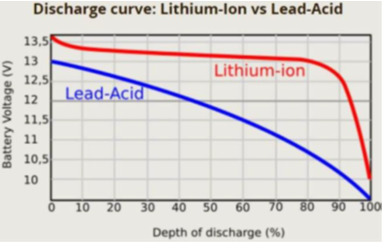
If powered by a lithium battery, the Seakeeper and BMS must be connected to a common NMEA 2000 network to prevent excessive discharge of the battery bank. An external BMS with a shunt can be used in place of a NMEA 2000 SOC signal, however, the Seakeeper will not provide any battery monitoring functionality. The following guide will explain the functionality of the user interface and menus.
- To access the battery monitoring configuration manager, press and hold the battery icon on the Home screen until the Battery Monitoring Configuration pop-up appears.
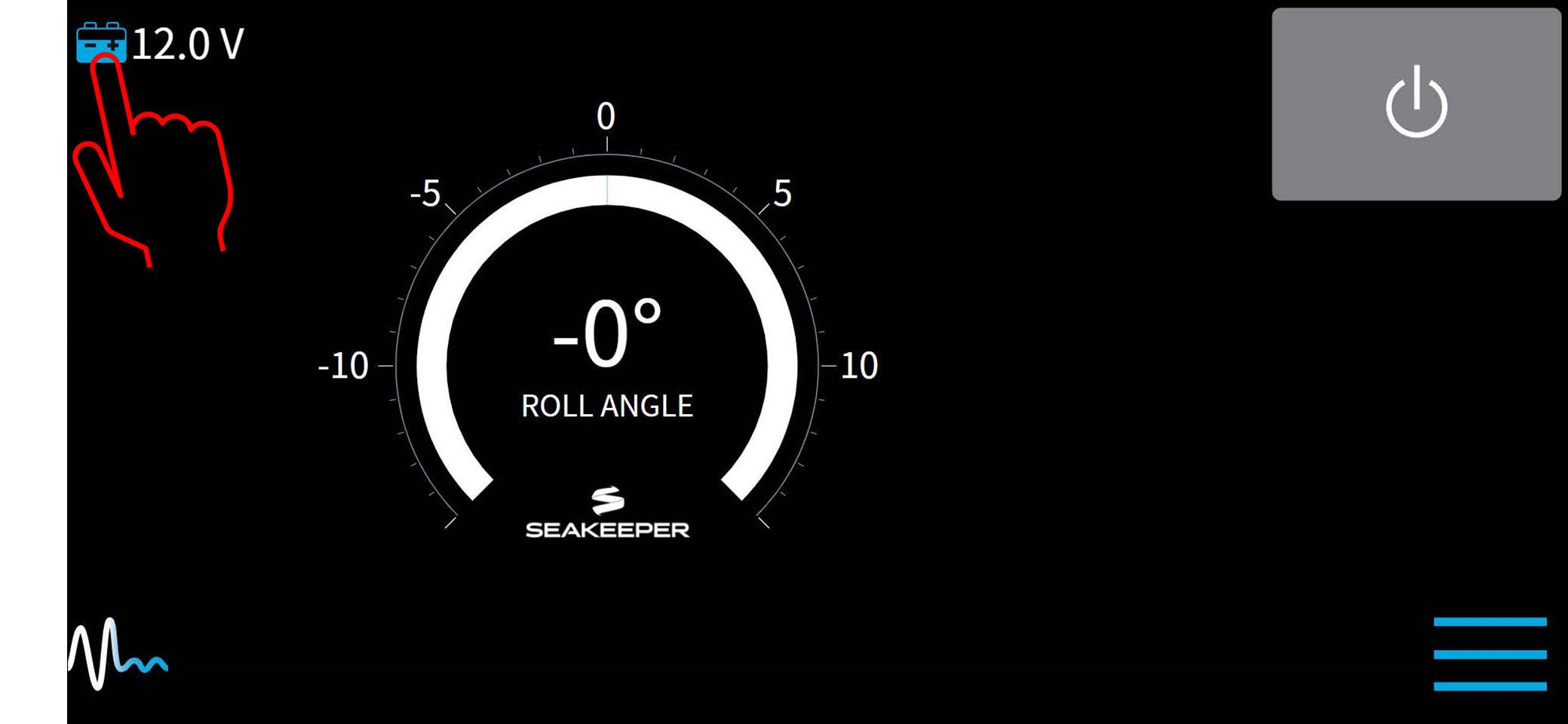
- The Battery Monitoring Configuration will initiate a pop-up after detecting the SoC signal automatically. From this pop-up window, one can also open the Battery Monitoring Configuration by pressing the Continue button.

- Once the Battery Monitoring Configuration manager window appears, press the dropdown menu down arrow and select SoC source from dropdown menu.

The dropdown options include:
- Battery SOC– This option allows the user interface to monitor the NMEA2000 network for the battery state of charge (required if lithium batteries are used to power the Seakeeper). When selected, the Cut-off threshold slider will determine at what battery charge the Seakeeper begins powering back to conserve battery power. Also, the 5” Touch Display will show battery state of charge.
- No Selection – This is the default setting for the configuration manager. Low voltage protection at 11.1 VDC is used until a different option is selected.
- Use voltage monitoring – This disables SoC logic and uses actual battery voltage to initiate lowering power drawn by the Seakeeper when battery voltage drops to 11.1 VDC on Seakeeper 1.
The Cut-off Threshold Slider controls the level of charge at which the Seakeeper will begin lowering the power it draws. The default setting is 20% charge. The slider allows the selection between 10% and 30% charge state.
7.0 Seakeeper Specifications
7.1 Specifications & Summary
| Rated RPM | 9,750 RPM |
| Angular Momentum at Rated RPM | 1,000 N-m-s |
| Anti-Rolling Torque at Rated RPM | 2,620 N-m |
| Spool-up Time to Rated RPM (9750 RPM) | 30 minutes (9,750 RPM) |
| Spool-up Time to Stabilization RPM | 15 minutes (7,0400 RPM) |
| Spool-up Power DC Motor | 600 Watts Max |
| Operating Power DC (Sea state dependent) | 300-600 Watts |
| Voltage DC Input | 12 VDC @ 55 Amps |
| Seawater Supply to Heat Exchanger | 4 GPM (15 LPM) maximum 2 GPM (8 LPM) minimum |
| Ambient Air Temperature | 32˚ – 140˚F (0 – 60˚C) |
| Weight | 365 lbs (165 kg) |
| Envelope Dimensions | 22.9 L x 23.6 W x 15.7 H (inches) 0.582 L x 0.598 W x 0.398 H (meters) |
| Noise Output | At full operating RPM, steady state noise measured in the factory at a 1-meter distance measures 62-64 dBC (sound levels may be higher during spool-up). |

8.0 Revision History
| Revision | Description | Date |
| 2 | Addition of revised ConnectBox design. Revised specifications. Addition of battery State of Charge logic. Minor editing throughout. | 29AUG2023 |